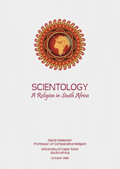At some moments, L. Ron Hubbard seemed to reject the designation “religion” for the beliefs and practices of Scientology. For example, he once observed that Scientology “is not a psychotherapy. It is a body of knowledge which, when properly used, gives freedom and truth to the individual.”13 In this context, however, Hubbard seems to have distinguished between the formal aspects of religion, such as creeds, practices, or membership, and the liberating truth. This way of distinguishing between “religion” and “truth” is a common religious strategy. For example, the Christian theologian Karl Barth insisted that his gospel was not a religion; it was truth. Maududi made the same claim for Islam, Franz Rosenzweig for Judaism, and Sarvepalli Radhakrishnan for Hinduism. In all these instances, religious thinkers have asserted the ultimate meaning and power of their “truth” by distinguishing it from religion.14
However, Hubbard also found that the term, “religion,” if properly defined, could be used to designate the liberating truth of Scientology. “Scientology,” Hubbard explained, “is a religion in the very oldest and fullest sense.” More than merely a “religious practice,” however, Scientology is a “religious wisdom.”15 The term “religion,” according to Hubbard, “can embrace sacred lore, wisdom, knowingness of gods and souls and spirits.”16 In these terms, therefore, Hubbard asserted that Scientology should be recognized as a religion.
Hubbard identified the Hindu, Buddhist, and Taoist roots of this religious wisdom. Like certain forms of Hinduism, especially Advaita Vedanta, Scientology supports the recognition that the human self is ultimately the supreme divine power of the universe. In the Sanskrit formula of the Vedanta, Atman (the human self) is Brahman (the divine). Like Buddhist practice, however, Scientology outlines a step-by-step trajectory towards liberation from ignorance that recalls the “Eightfold Path” of Buddhism. This Buddhist path moves through the stages of right understanding, dedication, communication, conduct, way of life, effort, awareness, and meditation to achieve a state of joyful liberation aloof from the world. In a similar way, Scientology identifies a religious path, or bridge, that marks out progress towards liberation. However, while the Buddhist path was designed in principle for a monastic life removed from ordinary human relations and occupations, the Scientology path has more in common with a Taoist approach to achieving spiritual harmony in the midst of the world. In the Taoist sense, liberation is a state of balance in which a human being is in harmony with all the conditions of existence. Scientology is directed towards attaining a similar harmony.
In its cosmology, Scientology identifies three basic aspects of reality—the life force that is referred to as theta, the Supreme Being that is also known as Infinity, and the physical universe of matter, energy, space, and time that is represented by the acronym, MEST.
Echoes of these ancient Asian religions, therefore, can be found in the religious beliefs of Scientology. However, Hubbard concluded that the ultimate goals of these religions—spiritual liberation, knowledge, and harmony—were only rarely achieved in practice. Reflecting on his travels in Asia, Hubbard observed that he saw a great many studying but very few arriving. According to Hubbard, the ancient religious paths lacked the sense of “urgency necessary to arrive.”17 A modern religion, he concluded, had to do more than identify spiritual goals; it had to provide the practical means for achieving them.
Scientology also has much in common with the alternative Christian and Jewish religious movements of antiquity known as Gnosticism. like the ancient Gnostics, Scientology teaches that human beings are essentially spiritual beings, with divine souls of pure light, that are caught up in the darkness of the material world. In its cosmology, Scientology identifies three basic aspects of reality—the life force that is referred to as theta, the Supreme Being that is also known as Infinity, and the physical universe of matter, energy, space, and time that is represented by the acronym, MEST. As a personalized form of the life force, the human soul—thetan—has become entangled in the forces of MEST. In the cosmic drama of Scientology, the thetan can be rescued from that entanglement in the conditions of the physical universe.
Scientology poses this liberation of the thetan as a matter of survival. Scientology’s “Eightfold Path” is the “Eight Dynamics” that represent successive stages of expansion in the basic urge for survival. The first four Dynamics are the “urge towards existence” of one’s self, family, group, and humanity; the next two are the urge for survival at the level of life forces and the physical universe; and the seventh and eighth Dynamics represent the ultimate spiritual survival at the level of souls and the Supreme Being. As Hubbard proposed, “the progress upward toward survival on higher levels is a progress, as well, toward God.”18 In this sense, the Eight Dynamics outline a path, not only for the liberation of the soul from the limitations of the physical world, but also for achieving an ultimate God-realization by existing at the level of the Supreme Being.
Like other religions, the Church of Scientology has a formal creed that presents its basic beliefs. Four major aspects of this creed can be identified. First, the Scientology creed emphasizes basic human rights. These rights are binding on every level of existence and therefore also represent the rights of human souls as free spiritual beings. All have equal and inalienable rights to freedom of religion, association, thought, expression, life, sanity, self-defence, and reproduction. To underscore the ultimate nature of these rights, the creed affirms that “no agency less than God has the power to suspend or set aside these rights, overtly or covertly.” Second, the creed announces a dedication to the religious healing of the human mind. That commitment is formulated in the belief that “the study of the mind and the healing of mentally caused ills should not be alienated from religion or condoned in nonreligious fields.” Third, the creed embodies an ethical orientation towards life that holds that “Man is basically good.” While that basic goodness is realized in harmony with others, “the laws of God” forbid any acts that would destroy or reduce the survival of another’s life, sanity, or soul. Finally, the Scientology creed declares a commitment to achieving salvation. “The spirit can be saved and,” the creed concludes, “the spirit alone may save or heal the body.”19
The salvation promised in the Church of Scientology does not depend upon having faith in the principles of this creed. As Hubbard argued, the question of faith has been one of the most misunderstood aspects of religion. He distinguished between having “faith-in” something and the spiritual character of “faith” itself. When a person has “faith-in” something, whether in a religious creed, a church, or a saviour, that person has surrendered his or her freedom as a spiritual being to the control of another. Having “faith-in” the beliefs of a religion ultimately results in “the sacrifice of one’s universe.” Faith itself, however, is the spiritual condition of being in harmony with the universe and God. In this specific sense, faith is “a full state of beingness. And with this condition, one could occasion Faith itself to occur within his own universe or could occasion people to have faith in him.”20 Scientology is directed towards achieving that unconditional faith. More than a matter of belief, that faith is a liberating knowledge that is attained through a specific course of action.





























